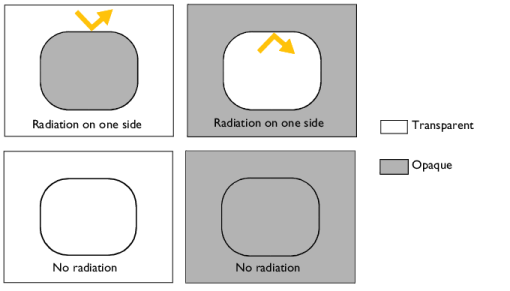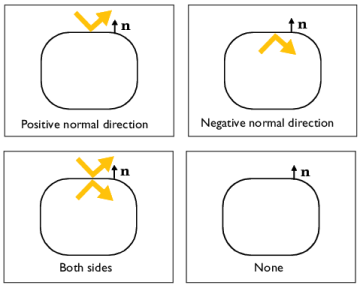|
•
|
Opacity controlled requires that each boundary is adjacent to exactly one opaque domain. Opacity is controlled by the Opacity (Surface-to-Surface Radiation and Orbital Thermal Loads Interfaces) domain feature. For external boundaries, the exterior side opacity is transparent by default but may be edited by setting the Selection of the Opacity feature on All voids in the Opacity feature. Figure 6-1 illustrates the emitted radiation direction depending on the opacity of the adjacent domain.
 |
|
•
|
Select Negative normal direction to specify that the surface radiates in the negative normal direction (un vector direction). An arrow indicates the negative normal direction that corresponds to the direction of the radiation emitted by the surface. Figure 6-2 illustrates the emitted radiation direction depending on the chosen option.
|
|
•
|
Select Positive normal direction if the surface radiates in the positive normal direction (dn vector direction). An arrow indicates the positive normal direction that corresponds to the direction of the radiation emitted by the surface. Figure 6-2 illustrates the emitted radiation direction depending on the chosen option.
|
|
•
|
Select Both sides if the surface radiates on both sides. Figure 6-2 illustrates the emitted radiation direction depending on the chosen option.
|
|
•
|
Select None when adjacent domains are either both transparent or both opaque for a given spectral band. When the Emitted radiation direction is set to None for a spectral band, the radiative properties set for this spectral band are not used
 |
|
•
|
When Emitted radiation direction is set to User defined for all bands (default), select a radiation direction that is the same for all spectral bands: Opacity controlled (default), Negative normal direction, Positive normal direction, Both sides, or None. Use this option if the transparency or opacity properties of the material are not wavelength dependent.
|
|
•
|
When Emitted radiation direction is set to User defined for each band, select a radiation direction for each spectral band: Opacity controlled (default), Negative normal direction, Positive normal direction, Both sides, or None. The Emitted radiation direction defines the radiation direction for each spectral band similarly as when Wavelength dependence of radiative properties is Constant. Defining a radiation direction for each spectral band makes it possible to build models where the transparency or opacity properties defers between spectral bands.
|
|
Note that when Wavelength dependence of radiative properties is set to Solar and ambient or Multiple spectral bands, the upper bound of the last spectral band, meant to represent the infinite, is set to 1[mm], for the computation of the surface material properties.
|
|
Set Tamb to the far-away temperature in directions where no other boundaries obstruct the view. Inside a closed cavity, the ambient view factor, Famb, is theoretically zero and the value of Tamb therefore should not matter. It is, however, good practice to set Tamb to T or to a typical temperature value for the cavity surfaces in such cases because that minimizes errors introduced by the finite resolution of the view factor evaluation.
|
|
•
|
When Ambient emissivity is set to User defined, enter a value or expression for the Ambient emissivity εamb. The wavelength may be accessed through the rad.lambda variable. Any expression set for the emissivity is then averaged on each spectral band to obtain a piecewise constant emissivity, with values εamb,i. If the average value of the emissivity on each band εamb,i is known, you may use instead the User defined for each band option to avoid the evaluation of the average.
|
|
•
|
When Ambient emissivity is set to User defined for each band, enter a value for the Ambient emissivity εamb,i for each spectral band. Within a spectral band, each value is assumed to be independent of wavelength.
|
|
•
|
When Diffuse irradiance is set to User defined, enter a value or expression for the diffuse irradiance.
|
|
•
|
When Diffuse irradiance is set to User defined for each band, enter a value or expression for the diffuse irradiance for each spectral band.
|
|
•
|
Select a Clear sky noon diffuse horizontal irradiance defined in an Ambient Properties node under Definitions to define the diffuse irradiance from ambient properties.
|
|
•
|
By default, the Emissivity ε (dimensionless) uses values From material. This is a property of the material surface that depends both on the material itself and the structure of the surface. Make sure that a material is defined at the boundary level (by default materials are defined at the domain level).
|
|
•
|
For User defined, set a value or expression. You can define a temperature-dependent emissivity using the variable rad.T.
|
|
•
|
|
•
|
When Emissivity is set to User defined, enter a value or expression for the Emissivity ε. The wavelength may be accessed through the rad.lambda variable. Any expression set for the emissivity is then averaged on each spectral band to obtain a piecewise constant emissivity. If the average value of the emissivity on each band is known, you may use instead the User defined for each band option to avoid the evaluation of the average.
|
|
•
|
When Emissivity is set to User defined for each band, enter a value for the Emissivity for each spectral band. Within a spectral band, each value is assumed to be independent of wavelength. By default, the same emissivity is defined on both sides. Select the Define properties on each side check box and fill the Upside and Downside columns of the table for a specific definition on each side.
|
|
To define temperature dependencies for the user inputs (surface emissivity for example), use the temperature variable ht.T, that corresponds to the appropriate variable (upside, downside, or average temperature of a layer, wall temperature with turbulence modeling), depending on the model configurations. See Boundary Wall Temperature for a thorough description of the boundary temperature variables.
|
|
Several settings for this node depend on the Wavelength dependence of radiative properties setting, which is defined for the physics interface.
In addition, the Transparent media refractive index is equal to 1 by default.
|
|
Upside and downside settings can be visualized by plotting the global normal vector (nx, ny, nz), that always points from downside to upside. Note that the normal vector (ht.nx, ht.ny, ht.nz) may be oriented differently.
|
|
Heat Generation in a Disc Brake: Application Library path Heat_Transfer_Module/Thermal_Contact_and_Friction/brake_disc
|